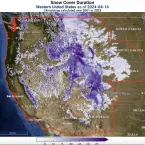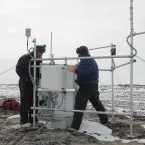Our Research
As climate changes, how do Earth's frozen areas affect our planet and impact society?
In this section
Related News & Stories
Filter by:

Analysis - Snow Today
Snow-covered area was 203 percent of average for April, ranking second highest in the 24-year satellite record. Despite a snowy April, snow cover days were below average because of a widespread slow start to the snow season. States in the north reported below-average snow water equivalent, while the opposite was true for states in the south.

Analysis - Sea Ice Today
April sea ice loss in the Arctic proceeded at a near-average rate overall, with the majority of ice losses in the Bering Sea and Sea of Okhotsk. In the Antarctic, sea ice grew faster than average, roughly evenly around the entire continent.

Analysis - Sea Ice Today
Following the 2024 maximum sea ice extent on March 14, Arctic ice extent has declined slowly such that 2024 March average is the fifteenth lowest in the passive microwave satellite record.

Analysis - Ice Sheets Today
In late February and early March, two record melt events for that time of year occurred on the Antarctic Peninsula. Overall, however, the 2023 to 2024 melt season was slightly below the 45-year average because of low melt regions outside of the Antarctic Peninsula.

Spotlight
The Silalirijiit Project was an innovative effort to engage community members and stakeholders to better monitor and understand the weather of Baffin Island’s Clyde River region. It combined state-of-the-art weather-monitoring technology with local Inuit knowledge.

Analysis - Snow Today
March started out dry in the western United States, but made significant gains in winter storms toward the end of the month, finishing tenth in snow-covered area over the 24-year-satellite record. Snow-covered area reached a maximum on January 17, 2024, spot on with the average over the data record.